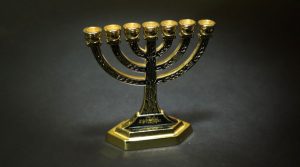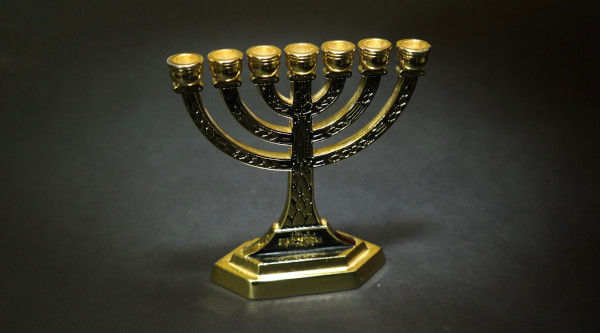
This week we read the parsha of B’haaloscha. “Speak to Aharon and say to him: When you kindle the lights; toward that central light on the Menorah itself (the Menorah was comprised of a center column, referred to as ‘the Menorah itself,’ with three branches rising out of each side of that central column) shall all seven lights cast their illumination. [8:2]”
Why does this parsha of the kindling of the Menorah follow immediately after the parsha dealing with the offerings brought by the Nesiim {Princes} of each tribe? Aharon felt a lacking when he saw the representatives of each tribe bringing their offerings while he and his tribe of Levi were not represented. Hashem consoled Aharon by informing him that his portion is greater than theirs–he kindles the lights of the Menorah. [Rashi 8:2]
The twelve Nesiim each brought the following offerings for the consecration of the altar: a silver k’arah {dish} and a silver basin, each filled with a mixture of flour and oil; a golden pan filled with incense and numerous animals to be sacrificed.
Although the identical offering was brought by each of them, the Torah deemed it worthwhile and necessary to spell out the details of these offerings twelve separate times. Why was this done?
The Ramban [7:4-5] explains that these identical offerings that were brought did not come about through a collective decision that was reached. Rather, each of the Nesiim, based totally on their personal reasoning, thought to bring this offering.
Each of the tribes had been told by Yaakov of the unique role and position that they would serve in Klal Yisroel {Yisroel as a whole}. The first to bring the offering was Nachshon from the tribe of Yehuda. From his tribe would come the royal kingdom of Israel. He therefore brought a bowl, representing the oceans that surround the earth and a basin, representing the round earth. His tribe, with the advent of the Moshiach {Messiah}, would supply the king who would include all of that in his dominion.
The second offering was brought by Nesanel from the tribe of Yissachar. He brought the same exact offering as Nachshon but for very different reasons. The tribe of Yissachar was wholly dedicated to Torah study. Torah is compared to bread because it sustains the spiritual aspects of man as bread sustains the physical aspects. Each loaf of the Lechem Hapanim {the special bread that were on the Shulchan-Table of the Mishkan-Tabernacle}, which represented this concept, was shaped by a k’arah. That was what Nesanel had in mind when he, representing the tribe of dedication to Torah study, brought the silver k’arah as his offering.
The third offering was brought by Eliav from the tribe of Zevulun. They were sea merchants who used the proceeds of their commerce to form a partnership with Yissachar. By graciously providing the material support for Yissachar, they equally divided the spiritual riches of Yissachar’s labor. Eliav brought a k’arah, resembling the sea upon which his tribe would travel.
The same applied to the remaining nine tribes. Each brought an offering that represented their unique involvement and that offering happened to be identical to that which each of the other tribes brought. That is why the gifts were spelled out in detail a total of twelve times–once for each tribe.
Perhaps that was the cause of Aharon’s feeling that he and his tribe were lacking because they had not brought this offering. Were they lacking a special, unique contribution to Klal Yisroel?
Hashem answered that he would be kindling the lights of the Menorah and as such, his was greater than theirs. What was this special aspect of the Menorah?
The Menorah was comprised of a center column with three branches rising out of each side. The Sforno explains that the three branches on the right represent those whose involvement is in the spiritual realm. The three branches on the left represent those who involve themselves in the materialistic realm in order to aid those involved in the spiritual. All six wicks pointed inward toward the main column of the Menorah which rose straight up toward the heaven, representing that all actions of this world must be dedicated and focused toward serving Hashem.
The middah {attribute} of Aharon and his descendants-disciples is a pursuer of peace. A pursuer of peace recognizes that dissension is not necessarily the result of one party being right and the other wrong. Rather, it can come about as a result of different views and perspectives on a given situation. One can be at peace with everyone when one recognizes the unique aspects and contributions that each individual offers. Even though different people’s ways might be different, it is only the combination of each contribution that brings about the complete sanctification of Hashem’s name.
The offerings of each of the Nesiim represented their unique path in serving Hashem. The Menorah represented the synthesis of all those paths into one heavenly thrust. Aharon was chosen to kindle the lights of the Menorah and to kindle the flames of peace and unity in the heart of each and every Jew. As such, Hashem told Aharon that there is no need for you to feel lacking. Yours is far greater than theirs.
May we be from the disciples of Aharon…
Good Shabbos,
Yisroel Ciner
Warmest wishes of mazel tov to Yehudis Chava (previously Greenfield) and Rueven Bauman on their marriage. May they share years of bracha and simcha together ad mea v’esrim shana!
Copyright © 2000 by Rabbi Yisroel Ciner and Project Genesis, Inc.
The author teaches at Neveh Tzion in Telzstone (near Yerushalayim).


